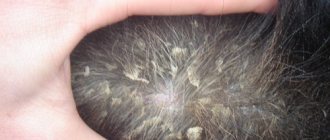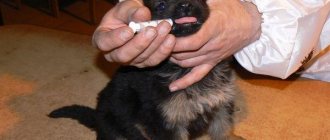Sensitive ears allow you not only to rely on the shepherd as an excellent watchman, but also to guide it from a great distance. A thick-bellied and thick-footed kitten of shepherd color with a long tail and thick fur can only be finally classified as a purebred when the German shepherd puppy’s ears stand up.
The ears of a real German Shepherd, according to the standard, are erect, of medium size, set high, with the ends directed forward and upward, not adjacent to the skull on both sides, even when the shepherd is in motion, presses his ears or lowers them in a calm state. This “blooming” of the ears is not a fault.
When a German Shepherd's ears stand up when excited, the distance between their highest points (ear tips) should be visually equal to the width of the auricle.
When do your ears stand up?
The process is completely individual and depends on many factors. Normally, a puppy’s ears stand up from one to 6 months.
When should you sound the alarm?
If after six months the ears remain droopy, you should show your pet to a specialist or carry out the correction yourself. After 7 months, it will be difficult and almost impossible to lift them.
However, experienced German Shepherd breeders claim that action should begin as early as 4 months. If, upon reaching this age, the puppy has any problems with the ears, he needs help.
To choose a healthy shepherd from a breeder, inspect your pet's ears:
- If they are too thin, they are less likely to stand up on their own.
- Small ears are more likely to stand up without your help.
- Closely spaced ears are more likely to rise.
When does a German Shepherd puppy's ears go up?
The recently born “German” doesn’t have them at all. This is absolutely normal . Each animal is individual and it is simply impossible to predict the exact day when a particular animal’s ears should stand up, that is, when it begins adolescence.
Basically, in representatives of this breed they begin to rise at the age of one and a half to five months, although there are cases when this happens later - up to eight months. Signs of the beginning of the formation of ears in a shepherd puppy are a significant increase in their size, due to the growth of cartilage tissue, they become heavier and denser.
Owners raising their first “German” are often concerned that the pet’s ears behave, so to speak, out of sync: one can confidently stand, while the other can hang or lie on its head. They are quite often placed in a kind of cap on the top of the head, or become a house. All this is very individual and unpredictable - no two animals are alike.
During this period of life, they look very funny; watching their furry friend grow up always brings pleasure to those around them. Approximately, by three months your child will begin to change teeth. This process is very closely related to the formation of the ears. Therefore, without having time to stand up normally, it may be that the German Shepherd puppy’s ears fell off. There is no need to be afraid of this - this is how this friend is genetically designed. Soon, around four to five months, the cartilage tissue will get stronger and the shepherd puppy’s ears will stand up again with renewed vigor.
Reasons why ears don't stand up
Problems with cartilage in a dog can be due to the following reasons:
- lack of calcium and phosphorus in the body;
- injury/illness in infancy;
- poor maternal nutrition during pregnancy;
- genetics, the puppy is not purebred.
How is the change of teeth related to ear cartilage?
It happens that by the age of 3 months the puppy’s ears stand up, and a month later they fall off again. This is normal and is associated with the change of baby teeth to molars. The body uses all the calcium that the puppy receives to form a new set of teeth. In this case, there is no need to worry. As soon as the change of teeth is completed, the ears will fall back into place. To be more confident, you can give the puppy food, see more details below.
When and what vaccinations to do?
Animals that are clinically healthy and free from helminthic infestation are subject to vaccination.
For puppies
First vaccination
In case of crowded housing, vaccination from 1.5 months of age with the “Puppy” vaccine or administration of serum is recommended. After the puppy vaccination, the “adult vaccine” is administered at intervals of 2-3 weeks.
Diseases for which the vaccine is indicated:
- canine distemper virus;
- adenovirus;
- parvovirus;
- parainfluenza;
- leptospirosis;
- rabies.
Most popular vaccinations
- "Nobivak" (Holland);
- "Kanigen" (France);
- "Eurikan" (France);
- "Vangard" (USA).
Distemper vaccine
There is some confusion about the etiology of this disease. True canine distemper is rarely diagnosed and is most often accompanied by neurological symptoms in small puppies.
Parvovirus enteritis is usually mistaken for plague. Both diseases are highly contagious and can be fatal. Each vaccination includes strains against these diseases. The very first vaccination includes parvovirus enteritis and canine distemper.
Adult dog
Vaccinations according to age. General vaccination plan:
- first vaccination at 2 months;
- revaccination after 21-30 days;
- then after changing teeth - at approximately 10 months.
Vaccination against rabies is mandatory and is carried out once a year, starting from 3 months of age. It is necessary to vaccinate annually; even older dogs can suffer from viral infections.
It must be remembered that the German Shepherd is also an artificially bred breed and there are diseases that even modern medicine is powerless to control, but proper care and maintenance will always be the key to the pet’s good health and mood.
What to do?
If your dog is more than six months old and his ears are still drooping, then they will have to be rewound. Before the procedure, be sure to consult a specialist.
It is important not to tape your dog's ears until he is six months old. Too early a procedure can cause damage to the ear.
Rewind
First you need to purchase materials. What you need for rewinding:
- large foam rollers;
- white surgical plaster in a spool;
- medical glue (preferably special dog glue, sold in veterinary pharmacies);
- wooden stick for fixing ears.
When everything you need has already been purchased, proceed to the procedure. Make sure everything is sterile and wash your hands thoroughly. The dog must be calm. The procedure is as follows:
- Wipe your puppy's ears with an antiseptic.
- Take curlers. Take the center out of them, leaving only the foam base. Take a pencil and insert it into the hole with the eraser first, but not all the way. The pencil is needed for stabilization; it will then need to be removed.
- Apply medical glue to the outside of the curler. Make sure there is not too much glue so that it does not get into the ear canal.
- Place your ear in a vertical position and attach curlers to the hanging part. Leave some distance between the edge of the curler and the dog's head so as not to close the ear canal. Apply a little pressure to your ear so that the curler can secure itself.
- While holding the pencil, wrap a bandage around your puppy's ear. Do not attach the patch too tightly so as not to cause discomfort to your pet. When it's all over, put the pencil away.
- Attach a wooden stick to the back of the ear. This will secure the ears in a standing position.
- After all the steps, it will take about 5-7 minutes for the patch to attach. Distract your puppy during this time: feed him a treat or play.
The patch is worn for 10-14 days.
Alternative way
Alternative ear fixation:
- Gently feel your dog's ears for weak cartilage. When you find one, the ears will immediately straighten.
- Cut a piece of cardboard slightly larger than the problematic cartilage.
- Disinfect your puppy's ears. Take an adhesive plaster and stick it on the weak cartilage. Lubricate a piece of cardboard with medical glue. Stick it on the plaster, then secure it with the 2nd layer of plaster.
Breeders and veterinarians prefer the first method. But if you don’t like it, the right to choose remains yours.
Shepherd puppy why ear fell off
Breed standard
According to the breed standard, the German Shepherd's ears are erect and pointed, set vertically and parallel to each other (not spread to the sides).
Broken and drooping ears are unacceptable and are considered conformation defects. The exception is puppies up to three months old! Their ears can be of almost all shapes and sizes: large, hanging, semi-erect, lopsided, and sometimes only one ear is standing. All this is normal and does not require special attention from the owner, except for light daily massage of the ear and providing the puppy with a balanced diet.
The shape of the ears depends on the condition of the cartilage. In a puppy, they are soft and are just beginning to thicken and strengthen. Over time, the cartilage will turn into an elastic cartilage plate, and the dog's ears will take on the desired shape.
When do a German Shepherd puppy's ears stand up?
Puppies are like children: each is individual and develops at its own pace. While the puppy is small, there is no need to worry. Let your baby grow up in peace: he has nowhere to rush!
But if the puppy is already 4-5 months old, and the ears still haven’t lifted, this is a reason to seek advice from the breeder and a veterinarian. It’s better not to delay this: after 6-7 months, it is much more difficult to correct the shape of the ears.
The ears of a German Shepherd begin to rise at the age of 1.5 to 2 months. They should fully rise by 6-8 months.
Is it necessary to place ears “specially”?
A healthy purebred puppy under 4-5 years of age does not need special ear placement. However, in some cases, you need to start gluing the ears according to a special scheme from the age of 3 months. Proper gluing of the ear, recommended by the breeder, will prevent the formation of cartilage fractures and the formation of incorrect posture.
The main task of the owner is to provide the pet with proper care. It includes: high-quality balanced nutrition, active games, timely vaccination, treatment against parasites, proper ear cleaning, protection from injury.
The correct shape of a German Shepherd's ears is a consequence of genetic and physical health, as well as proper care.
Why don't German Shepherd ears stand up?
A small puppy's ears may not stand up due to age. But this is not the only reason. There are factors that interfere with the correct formation of cartilage, and with it the shape of the ear.
1. Unbalanced diet. You can’t go anywhere without a quality diet! A lack of calcium and phosphorus in the body, as well as collagen, prevents the proper formation of cartilage tissue. If your puppy doesn't have the right diet, his ears may not rise up. Improper nutrition implies not only low, unbalanced quality of food, but also its inconsistency with the puppy’s needs, including in terms of portion size. The puppy should receive exactly as much as he needs. Avoid overfeeding!
2. Inactive lifestyle. Optimal physical and mental stress is the basis for the harmonious formation of all systems of his body, including cartilage tissue.
3. Past diseases. Proper formation of cartilage can be interfered with by ear inflammation, otodecosis, and serious infectious diseases. They slow down the physiological development of the body. In such cases, the puppies' ears rise later than usual or remain lop-eared.
4. Ear injuries. Congenital and acquired injuries can affect the shape of the ear. For this reason, it is better to avoid situations where puppies, while playing, pull each other’s ears, etc.
5. Unsuitable living conditions and stress.
6. Genetic factors. If the puppy's parents had problems with the shape of the ears, they can be highly likely to be inherited. When buying a puppy, be sure to immediately ask the breeder what specific ear care is required during what growth periods, taking into account the characteristics of the line from which the puppy comes. In some lines, problems with ear strength and setness are practically not encountered, while in a number of others it is necessary to start gluing the ears and adding special collagen-containing additives from 3 months.
If you suspect that your German Shepherd's ears are not developing properly, contact your veterinarian and breeder. They will allay your concerns or suggest methods to resolve the problem.
After care
The most important part of ear rewinding is post-procedure care. A playful baby will try to pull off an unknown structure. Your task is to prevent this from happening. The first day after rewinding is usually the most difficult, because the dog did not have time to get used to the patch.
It happens that even after gluing the puppy’s ears fall off again. To prevent this from happening, follow these rules:
- Provide your pet with high-quality, nutritious food;
- protect the animal from injury: do not allow children to torture the dog, do not allow fights with other dogs;
- do not leave the animal in the cold for a long time.
What supplements should you give your puppy?
To stimulate ears to set, provide your puppy with a tablespoon of cottage cheese at each feeding. This will compensate for the lack of calcium. But we do not recommend using special calcium supplements, as this may lead to health problems in the future. But you shouldn’t give up vitamin supplements for dogs. This will strengthen the growing body and will not cause any harm. To make your puppy move his ears more, give him something to chew on from time to time.
How many months does a German Shepherd's ears stand up and why sometimes this doesn't happen?
The question is asked primarily by novice breeders, because erect ears are a breed characteristic. Initially, Chihuahua puppies are born with floppy ears. As they grow older, the ear muscles and cartilage become stronger, and the posture takes a vertical position.
An experienced breeder knows that, as a rule, Chihuahuas' ears stand up at 2-3 months. If the puppy is more than 8 months old, but they are still not standing, then there is a high probability that they will not stand up. Possible reasons include:
- genetic defect or heredity;
- calcium deficiency in the puppy’s body;
- suffered severe stress or immunodeficiency;
- a cross with another breed (for example, a dachshund);
- improper diet of a pregnant bitch during pregnancy.
Professional breeders note that long-haired Chihuahuas have ears that stand up a little later. Caused by increased consumption of calcium for the formation of hair and wool.
To install Chihuahua ears at home by gluing, you will need the following available tools:
- antiseptic (hydrogen peroxide 3%, chlorhexidine, alcohol, etc.);
- cotton pad or cloth;
- fixing patch (for example, Hartmann Omnipor or Veropharm);
- empty plastic bottle or cardboard medicine packaging;
- scissors.
- We degrease the inner surface of the Chihuahua's ear with a cotton pad soaked in an antiseptic.
- From a plastic bottle or cardboard packaging, cut out a strip slightly shorter than the length of the puppy’s ear, 5-10 mm wide. We round off the ends.
- From adhesive tape we cut out 4 pieces in the shape of an ear, but slightly smaller in size.
- Glue a strip of cardboard or plastic to the adhesive side of the patch exactly in the center.
- We take the second piece of plaster and glue it with the non-adhesive side to the piece with the strip.
- We press the resulting clamp against the inner surface of the puppy’s ear, starting from the fold line.
- We make sure that the patch is securely fixed, placing the ears vertically.
- We glue the second ear of the Chihuahua using the same method.
READ Why cats don’t take root in the house
After 7-10 days, remove the retainer and evaluate the result. If necessary, re-glue. For a visual understanding of the process, watch the following video.
Floppy ears should not be a reason to give up your Chihuahua puppy. A dog needs love, care and reliable support from its owner. What do you think? Please write your opinion in the comments.
Ear placement: detailed instructions
How many months should ears be placed? Start when your pet is six months old. In order for the recalcitrant shells to take the correct position, they are wrapped for a while. The manipulation is not very difficult, but it is better to do it the first time under the guidance of an experienced dog handler.
To install ears on a puppy, purchase the following materials:
- Large foam rollers to fit inside the sink. You can twist a tube from thin foam rubber.
- The pencils are not sharpened.
- White surgical plaster, 50 mm wide.
- Medical glue.
- Flat wooden popsicle stick.
The hair inside the ears is first trimmed with blunt scissors or shaved. The axle is removed from the curler and replaced with a 25 mm pencil.
This is necessary to stabilize the foam tube when inserted into the auricle.
Apply glue carefully, covering ¾ of the area of the foam tube. Avoid getting droplets into the ear canal or onto your hands.
An alternative to glue is to wrap the foam rubber with adhesive tape, sticky side out. In this case, you won't need a pencil.
Insert the curlers as shown in the picture.
Lightly press the tube against the sink wall to ensure the insert adheres.
The next step is to cover the ear with a plaster. Hold the foam tube by the protruding edge of the pencil and begin wrapping the bandage from top to bottom. The winding should be made tight, but not too tight, so as not to cause discomfort or impair blood circulation.
After finishing the winding, carefully pull out the pencil. If one sink is upright and the other needs to be positioned, wrap both
To stabilize, apply the stick to both ears, secure with adhesive tape or glue.
Keep your puppy busy for about 5 minutes with some kind of game so that he is distracted from his ears, and during this time the glue has time to dry.
Try to keep your pet alone in a calm environment. If there are other puppies in the apartment, they may tear off the winding while playing. The puppy himself is not averse to getting rid of a foreign object. The first day is the most dangerous; later the pet will get used to it and will not try to free itself. Therefore, monitor the condition of the dressing and eliminate defects as they occur.
Do not let the bandage get wet; cover the puppy's head with a bag or umbrella when it rains.
It will take up to two weeks for the standing position to stabilize. To make removal of the bandage painless, use adhesive solvent.
Watch the video:
On topic: Types of shepherd dogs with photos
In what cases should you contact the clinic?
The veterinarian will hardly be able to help if the puppy’s ears do not stand up due to heredity.
Cases in which it makes sense to visit the clinic:
- Uncertain ear placement or completely drooping ears at 5–7 months.
- Alternate falling or drooping of one ear in a puppy over 6 months old.
- Curled edges of the ears, against a background of hardened ear cartilage.
- Weight loss and, as a result, drooping ears.
- An ear drooping to one side, constant restlessness, shaking the head are a sign of otitis media.
Remember! It is believed that ear placement can be corrected within 8 months. If the problem is health, gluing and other manipulations will not help.










